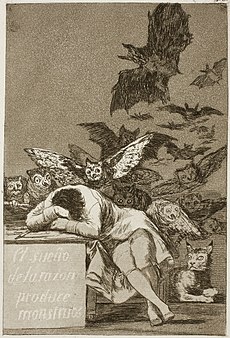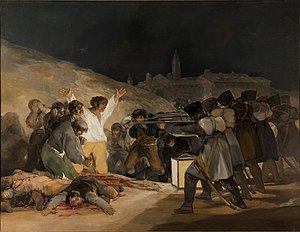
El sueño de la razón produce monstruos, c. 1797-99
The Sleep of Reason Produces Monsters
Salon Magazine's premier hate monger, Jeffrey Tayler recently dipped into the common received cultural lore of atheism to use Francisco Goya's print as a condemnation of religion. Goya's print was part of his great series Los Caprichos, condemning the corruption of the Royal-religious establishment in late 18th century Spain. Meanwhile, just north of the border, reason was deified by the French revolutionaries, reason was turned into a replacement for God and its promotion turned into everything from a popular cult (erecting an idol of "Reason" in the Cathedral of Notre Dame) to a political ruse and, in that most typical of French ways, a fashion statement. And that continues down to today among atheists, "free thinkers*, and barroom blowhards of whom a large number spout ignorantly in Salon magazine, Alternet, even in such better venues as The Nation and In Theses Times.
But the test of reality that reason as a replacement for God was given during the time that Goya was making his series of etchings. As compared to such often cited and, admittedly evil evils as the Spanish Inquisition were restrained in their violence as compared to the cult of reason in France during the Revolution and in its aftermath as such secular "reason" continued. The estimate for all of those who were executed after being condemned by the Inquisition are between 3,000 and 5,000 people over the course of centuries. The overwhelming majority of those brought before The Inquisition were either found not guilty or were allowed to repent and reenter into society without harm, as compared to the various courts under secular authorities, The Inquisition was far less likely to end up killing you or torturing you as they killed you. The goal of The Inquisition was to save souls, not kill people who endangered worldly powers. You can compare that to the French revolutionary courts and the not infrequent resort to summary execution in which even the most ardent of worshipers of "reason" in the French Revolutionary manner found themselves in the tumbrel to that most emblematic machine of such reason, the Guillotine. A number I've seen estimates the toll of those who died by guillotine as 16,594 with as many as 25-30,000 killed through summary execution, and that's only for the months of the "official" Reign of Terror. The figures for the entire term of the revolution are far higher, higher still if you include the aftermath of the glorious French Revolution in the military despotism and imperial adventures of Napoleon** which Goya documented in his later series of etchings, c. 1810-1820.
For my purpose it is interesting to consider this less often cited Con razon ó sin ella, with reason or without her.
Which was in his great and terrible series about the fate of the Spanish people under the benefits of Napoleon's liberation from the old Spanish regime the depravity of which Goya's previous series documented. It is noteworthy how many of those hideously killed by the French in Goya's later series informed by his witness of the benefits of such "reason" were priests and Franciscan friars. Such as in his famous painting The Third of May

Reason, as presented by the anti-religious cult of reason in France and as is still admired in ignorance by secularists-atheists today, turned out to be the falsest of gods, racking up a body count far higher in far less time than the Church's Inquisition and even more than under the often mentioned Spanish Inquisition which was administered by the crown, not the Church.
It is important to consider what place The Inquisition holds today in the official words of The Catholic Church as compared to the secularist-atheist presentation of the horrific violence under the regime of "reason" and, later science as seen in governments controlled by committed atheists. You can compare the public confession made in 2000 by Pope John Paul II and the future Pope Benedict XVI (two of my least favorite of recent popes, by the way) in which they admitted the crimes of the Inquisition and other such events in the history of the Catholic Church. I don't know of any well respected member of the Catholic Church who would defend the actions of the Inquisition today and there have been many in the past who condemned those sins.
I don't see that atheists are about to admit the role that atheism played in historical horrors or those that continue today. I don't see them even admitting what's obvious about that to anyone who wants to look at what happened after Monsieur Arouet, the sleazy watch peddler and lottery gamer, sycophantic swindler of what was probably the greatest slave holder of his time, Catherine The Great and other fans of Enlightenment reason, died. Christianity holds that moral reflection, examination of conscience, confession of sin and sinning no more is one of the highest uses of reason. Materialism doesn't hold any of those requirements, atheism doesn't.
* For newcomers, I've gone over and over again how materialism, the almost universal basic belief of atheists, makes "free thought" impossible, everything under it being a matter of material causation and, in its most radical form, consciousness being nothing but an illusion, which would, inescapably, include reason. Though atheists almost never want to consider what is necessarily the result of reasoning through their faith.
** Napoleon's position as a liberator and a figure of reasoned enlightenment is one of the most bizarre instances of refusing to see what is right in front of you and the falseness of slogans that modern history provides. It is recapitulated in the cults of Lenin, Stalin, Trotsky, Mao, etc.
No comments:
Post a Comment